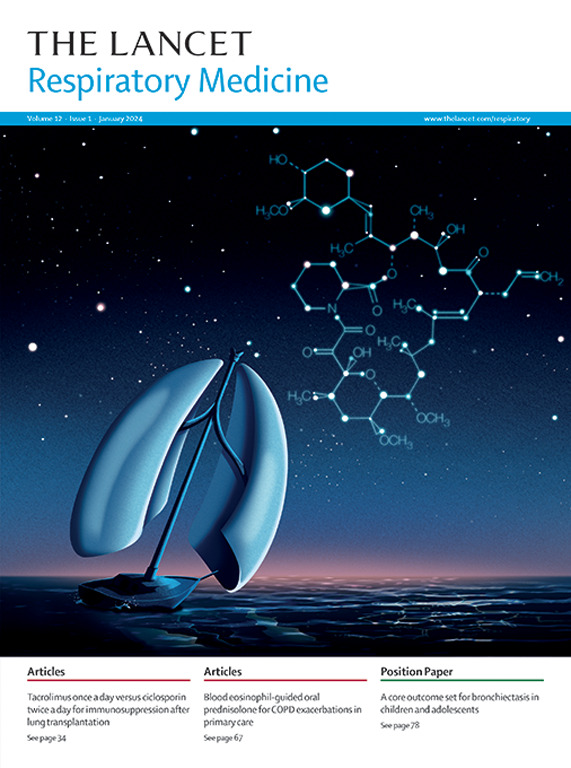Adjuvant chemotherapy for stage IA–IIA non-squamous, non-small-cell lung cancer identified as molecular high-risk by a 14-gene expression profile (AIM-HIGH): an international, randomised, phase 3 trial
IF 32.8
1区 医学
Q1 CRITICAL CARE MEDICINE
引用次数: 0
Abstract
Background
Survival for non-small-cell lung cancer (NSCLC) remains unacceptably low, even in stage IA–IIA. Current guidelines recommend adjuvant treatment for patients considered to be at high risk in stages IB and IIA, but suggest criteria that have not been validated to predict benefit. A previously validated, CLIA-certified 14-gene expression profile has identified patients with high-risk non-squamous NSCLC tumours in stages IA–IIA who benefitted from adjuvant chemotherapy in a non-randomised prospective study. In this prespecified interim analysis, we aimed to assess the efficacy and safety of platinum-based adjuvant chemotherapy in patients with stage IA–IIA molecular high-risk non-squamous NSCLC in a randomised trial.Methods
AIM-HIGH, a randomised, phase 3 trial, was done at 45 centres in France, Germany, and the USA. Patients aged 18 years or older with stage IA–IIA non-squamous NSCLC, an adequate tumour sample, and an Eastern Cooperative Oncology Group performance status of 0–1 underwent risk stratification with the 14-gene assay. Patients with a molecular high risk, defined as those receiving a high-risk or an intermediate-risk score, were randomly assigned (1:1) to four cycles of platinum-based adjuvant chemotherapy (using local institutional standard of care regimens) or observation. Randomisation was stratified according to age, sex, and tumour size of 4 cm or more. The primary outcomes for the study and for this prespecified interim analysis were 48-month and 24-month disease-free survival, respectively, in the modified intention-to-treat (mITT) population, which was defined as randomly assigned patients who continued to meet eligibility criteria either at chemotherapy initiation or at random assignment to observation; an early interim analysis was prespecified to detect a large difference between groups. This trial is registered at ClinicalTrials.gov, NCT01817192, and is closed to enrolment.Findings
Between Sept 11, 2020, and Feb 7, 2025, 449 patients were enrolled and underwent risk stratification. 236 patients with molecular high risk were randomly assigned to chemotherapy (n=124) or observation (n=112). At the time of the prespecified interim analysis, 87 patients were evaluable in the mITT population (47 [54%] males and 40 [46%] females; median age 63 years [IQR 52–74]) in the chemotherapy group and 107 (58 [54%] males and 49 [46%] females; 66 years [56–76]) in the observation group. 48 (55%) patients in the chemotherapy group and 58 (54%) patients in the observation group had stage IA disease; 34 (39%) and 44 (41%), respectively, had stage IB disease, and five (6%) and five (5%), respectively, had stage IIA disease. Six (3%) of 200 patients in the mITT population had died at the time of the interim analysis. 24-month disease-free survival was 96% (95% CI 92–100) with adjuvant chemotherapy versus 79% (70–90) with observation (hazard ratio 0·22 [0·06–0·76]; p=0·0087).Interpretation
The 14-gene assay identified patients with molecular high risk who benefitted from adjuvant chemotherapy. Use of the assay to determine eligibility for adjuvant therapy in stage IA–IIA non-squamous NSCLC has the potential to substantially improve otherwise persistently poor outcomes.Funding
Razor Genomics.辅助化疗治疗通过14个基因表达谱(AIM-HIGH)确定为分子高风险的IA-IIA期非鳞状非小细胞肺癌:一项国际随机3期试验
非小细胞肺癌(NSCLC)的生存率仍然低得令人无法接受,即使是在IA-IIA期。目前的指南建议对IB期和IIA期高风险患者进行辅助治疗,但建议的标准尚未得到验证,无法预测获益。在一项非随机前瞻性研究中,先前经过验证的clia认证的14个基因表达谱确定了IA-IIA期高风险非鳞状非小细胞肺癌患者从辅助化疗中获益。在这项预先指定的中期分析中,我们旨在通过一项随机试验评估以铂为基础的辅助化疗对IA-IIA期分子高危非鳞状NSCLC患者的有效性和安全性。方法sam - high是一项随机iii期试验,在法国、德国和美国的45个中心进行。年龄在18岁或以上的IA-IIA期非鳞状NSCLC患者,肿瘤样本充足,东部肿瘤合作组表现状态为0-1,采用14基因测定进行风险分层。分子高危患者,定义为接受高风险或中度风险评分的患者,随机分配(1:1)到四个周期的铂类辅助化疗(使用当地机构标准护理方案)或观察。随机分组根据年龄、性别和肿瘤大小≥4cm进行分层。该研究和这项预先指定的中期分析的主要结果分别是改良意向治疗(mITT)人群的48个月和24个月无病生存期,其定义为随机分配的患者,在化疗开始时或随机分配到观察时继续符合资格标准;预先指定早期中期分析以检测组间的较大差异。该试验已在ClinicalTrials.gov网站注册,编号NCT01817192,并已结束报名。在2020年9月11日至2025年2月7日期间,449名患者入组并进行了风险分层。236例分子高危患者随机分为化疗组(n=124)和观察组(n=112)。在预先指定的中期分析时,在mITT人群中有87例患者可评估(男性47例[54%],女性40例[46%];化疗组中位年龄63岁[IQR 52-74]),其中男性58例[54%],女性49例[46%];66岁[56-76])。化疗组48例(55%),观察组58例(54%)为IA期;34例(39%)和44例(41%)为IB期疾病,5例(6%)和5例(5%)为IIA期疾病。在中期分析时,200例mITT患者中有6例(3%)死亡。辅助化疗组24个月无病生存率为96% (95% CI 92-100),而观察组为79%(70-90)(风险比0.22 [0.06 - 0.76];p = 0·0087)。14基因分析确定了从辅助化疗中获益的分子高风险患者。使用该检测来确定IA-IIA期非鳞状NSCLC是否有资格接受辅助治疗,有可能显著改善其他持续不良的预后。FundingRazor基因组学。
本文章由计算机程序翻译,如有差异,请以英文原文为准。
求助全文
约1分钟内获得全文
求助全文
来源期刊

Lancet Respiratory Medicine
RESPIRATORY SYSTEM-RESPIRATORY SYSTEM
CiteScore
87.10
自引率
0.70%
发文量
572
期刊介绍:
The Lancet Respiratory Medicine is a renowned journal specializing in respiratory medicine and critical care. Our publication features original research that aims to advocate for change or shed light on clinical practices in the field. Additionally, we provide informative reviews on various topics related to respiratory medicine and critical care, ensuring a comprehensive coverage of the subject.
The journal covers a wide range of topics including but not limited to asthma, acute respiratory distress syndrome (ARDS), chronic obstructive pulmonary disease (COPD), tobacco control, intensive care medicine, lung cancer, cystic fibrosis, pneumonia, sarcoidosis, sepsis, mesothelioma, sleep medicine, thoracic and reconstructive surgery, tuberculosis, palliative medicine, influenza, pulmonary hypertension, pulmonary vascular disease, and respiratory infections. By encompassing such a broad spectrum of subjects, we strive to address the diverse needs and interests of our readership.
 求助内容:
求助内容: 应助结果提醒方式:
应助结果提醒方式:


